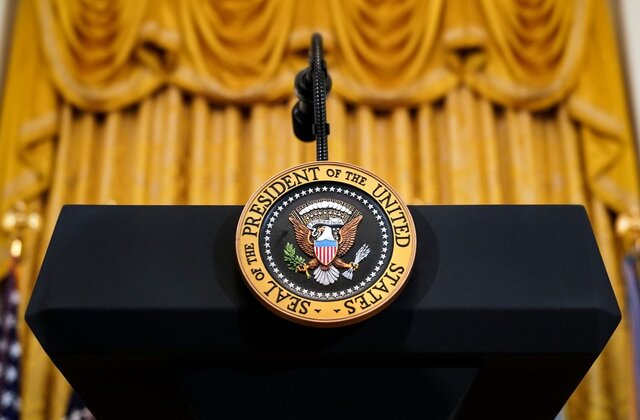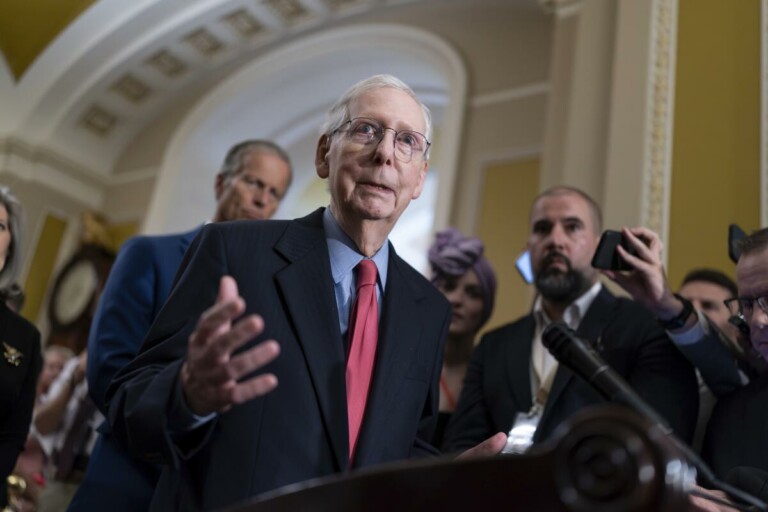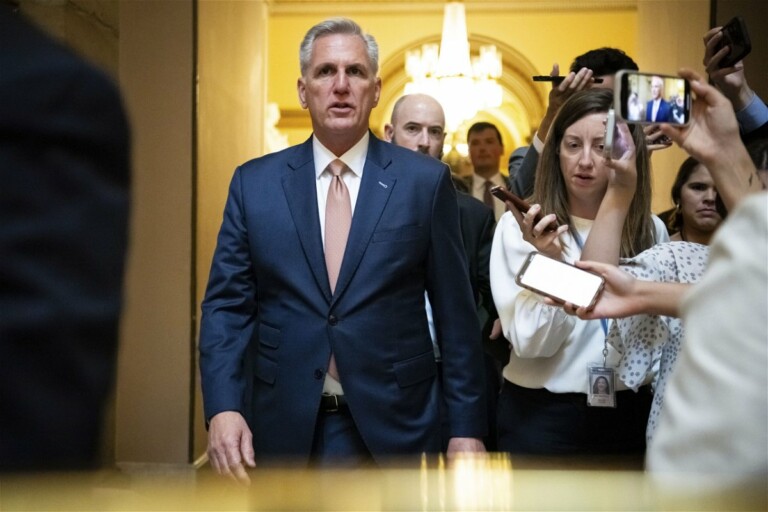The 2024 election promises to feature several major battlegrounds, but for sheer breadth of competitive contests, North Carolina next year will be hard to beat.
It starts with the presidential race. Recent presidential contests in North Carolina have been close: In 2020, Donald Trump won North Carolina by about 74,000 votes out of more than 5.5 million cast. Experts expect a competitive race again in 2024.
In addition, a newly empowered GOP majority on the North Carolina Supreme Court is poised to redraw the congressional map to benefit Republicans, producing the possibility of competitive races.
Meanwhile, the parties will fiercely contest both chambers of the legislature, which the GOP currently controls by narrow supermajorities, thanks to a Democrat-to-Republican party-switcher in the state House earlier this year. That party switch, by state Rep. Tricia Cotham, now enables Republicans to enact a strongly conservative agenda over the vetoes of Democratic Gov. Roy Cooper if they wish.
Cooper, for his part, is term-limited, teeing up a knock-down, drag-out contest to succeed him, likely between Democratic Attorney General Josh Stein and Republican Lt. Gov. Mark Robinson.
And that isn’t it for falling dominoes: The decisions by Stein and Robinson to seek the governorship leave their old offices of attorney general and lieutenant governor up for grabs in 2024, joining the GOP-held offices of state treasurer and labor commissioner as open-seat contests. The Democratic-held offices of secretary of state and auditor and the Republican-held offices of schools superintendent, insurance commissioner and agriculture commissioner will also be contested in 2024, with varying degrees of competitiveness.
In other words, in 2024, North Carolina will be one of the centers of the political universe – important in part because it’s a uniquely competitive state.
“There’s no telling who will win in 2024, but I’d bet half-court tickets to the UNC-Duke game that it will be close and North Carolina will retain its title as the definition of ‘purple,’” says Chris Cooper, a Western Carolina University political scientist (and no relation to the governor).
In recent years, North Carolina has mostly hosted close statewide races. During the 2020 and 2022 elections, North Carolina held 16 federal and state races for statewide office – and no candidate in any of them won more than 54% of the vote.
In addition, unlike most states in this highly polarized age, North Carolina has elected a thorough mix of Democrats and Republicans to statewide executive offices, which suggests that voters in the state – or at least a crucial subset of them – are willing to split their tickets.
The Republicans have done best in Senate and presidential contests. In those races, the GOP has kept a consistent – if modest – edge. It’s been a decade and a half since a Democrat has won one of those races. The last to win were Kay Hagan for Senate and Barack Obama for president, both of them way back in 2008.
“North Carolina has proved to be a purple state, but not necessarily a swing state,” says Cooper, the political scientist. “The statewide outcomes have been among the closest in the country, but Republicans have found themselves just on the winning side of the razor’s edge for presidential and Senate elections.”
The most intriguing contrast one can draw for North Carolina is with one of its neighbors to the south. Could North Carolina follow Georgia’s path in voting blue for Senate and presidential elections?
For the better part of two decades, Georgia, like North Carolina, had voted consistently Republican in key federal races – until 2020. That year, Democrats Jon Ossoff and Raphael Warnock won uphill, and narrow, victories for Senate seats, while Biden was winning the state in the presidential race. In 2022, Warnock won another close election to a full six-year term.
What changed in Georgia?
In an era when urban areas have grown bluer by the year, Georgia has seen its major metro area – Atlanta – steadily move toward the Democrats. In 2000, metro Atlanta backed Republican George W. Bush by 4 points. By 2020, the Atlanta metro area backed Biden by 28 points, a whopping 32-point shift.
North Carolina’s biggest metro areas saw a similar pattern.
North Carolina’s Raleigh-Durham metro area backed Gore in 2000 by less than a point. Two decades later, Biden won it by 26 points. The state’s most populous county, Wake County (which includes Raleigh and Cary), favored Bush in 2000 by about a point, but backed Biden by 27.
Similar patterns held in the North Carolina portion of the Charlotte metro area. In 2000, Bush won the Charlotte metro area by 18 points. But by 2020, Biden won the region by 4 points – a 22-point shift. The state’s second largest county, Mecklenburg County (which includes Charlotte), voted for Bush by almost 3 points in 2000 but Biden by a massive 36 points.
Such shifts helped the Democrats narrow the statewide gap substantially in North Carolina. In 2000, Bush defeated Gore statewide by 13 points, whereas Trump defeated Biden by about 1 point.
But these shifts weren’t enough to tip the state to the Democrats in the presidential race. A big reason why: Raleigh-Durham and Charlotte don’t have as large a footprint in North Carolina as metro Atlanta does in Georgia.
In 2020, Atlanta’s metro counties accounted for just shy of a majority of votes cast in Georgia – 49%, up from 46% in 2000. So even as outlying Georgia was growing redder – backing Bush by 19 and Trump by 26 – Democrats were able to turn a 12-point statewide loss by Al Gore in 2000 into a narrow victory for Biden in 2020.
By contrast, the Raleigh-Durham and Charlotte metro areas account for a minority of the state’s voters, growing from 36% of the votes cast in 2000 to 42% in 2020.
In other words, in North Carolina, the Democratic gains in the two big metro areas were nearly canceled out by the large and growing GOP margins elsewhere.
“North Carolina has the second most rural voters in the country after Texas, so running up the score in Raleigh-Durham and Charlotte won’t get you victory the way Atlanta does in Georgia,” says Cooper, the political scientist. “There’s been a massive Republican gain in rural areas”
Over the next quarter-century, Wake and Mecklenburg counties are projected to grow dramatically faster in population than most other North Carolina counties, according to calculations by the state’s Board of Science, Technology & Innovation. Over the long term, this could make the state bluer.
But for now, North Carolina’s political balance of power belongs in the hands of “countrypolitan” counties, a term coined by Mac McCorkle, a longtime North Carolina consultant who now teaches at Duke University’s Sanford School of Public Policy, and Rachel Salzberg.
These 28 counties sit within the economic and commuting orbit of North Carolina’s metro areas, but they’re located on the outlying edge, and they lack the racial diversity, college attainment levels and higher incomes that increasingly align with voting Democratic.
By McCorkle’s and Salzberg’s calculations, “countrypolitan” counties backed Trump in 2020 by a gaping 63%-36% margin, and collectively they provided Trump with about 50% more raw votes than North Carolina’s 50 most rural counties did.
That’s a major reason why Republicans have remained modestly ahead in North Carolina, at least in high-profile federal races, experts say.
To do well in North Carolina, says Western Carolina’s Cooper, “Democrats don’t have to win the rural vote, but they have to avoid getting pummeled.”
This is the goal of Anderson Clayton, the newly installed head of the state Democratic Party. At 25, Clayton, an Appalachian State University graduate, is the youngest state Democratic chairman in the nation.
“One of the things that I think that I learned from being on national campaigns is that a lot of times the national party is not looking at rural places like they should be,” Anderson told an audience in Union County, according to The Washington Post. “They’re looking at it as a place of a problem. And for me, I got really frustrated with that. It was part of the thing that called me home.”
This advice doesn’t just hold for presidential and Senate races, political observers say. It will also help determine whether Democrats can stay competitive in North Carolina’s state-level offices or whether Republicans start running away with them.
Since the dawn of the 20th century, North Carolina has elected only three Republican governors – one for a term in the 1970s, one for two terms in the 1980s and 1990s, and one for a term in the 2010s.
Historically, the successful Democratic model for winning North Carolina gubernatorial races has been to nominate a candidate who can win in metro areas but who hails from less populated regions of the state and connects with voters there. A good example is the current governor, who helped his family farm tobacco while growing up.
But the pool of potential Democratic candidates from more rural areas “has dried up,” says Rob Schofield, the editor of the online publication NC Newsline. Lining up Democratic candidates to run everywhere, as Clayton seeks to do, will be challenging.
“That counts on people running even if they know they will lose and be sacrificed, which is a hard sell,” says Ferrel Guillory, an emeritus professor of political science at the University of North Carolina.
In any case, the likely 2024 Democratic gubernatorial nominee, Stein, is set to break his party’s historic mold. Stein, a former legislator who has won two terms as attorney general, grew up in Chapel Hill, home of the University of North Carolina, and earned his undergraduate degree from Dartmouth and a law degree and a master’s of public affairs from Harvard.
Meanwhile, Stein’s potential Republican opponent also represents departure from past Republican gubernatorial candidates, who have tended to be economic conservatives from metro areas: Robinson is an outspoken social conservative who has flirted with conspiracy theories, ranging from the moon landing to crisis actors in school shootings.
Robinson doesn’t have a clear path to the nomination. In the primary, he faces state Treasurer Dale Folwell, former Congressman Mark Walker, former legislator Andy Wells and retired health executive Jesse Thomas. But he’s considered the front-runner, due to a strong core of support in a state where, by law, 30% plus one is enough to win a primary.
If the race comes down to Stein and Robinson, as conventional wisdom suggests, “it will be an epic and titanic battle that will be bitterly divided and deeply polarizing,” says Michael Bitzer, a professor of politics and history at Catawba College. “Probably the most expensive gubernatorial race in the nation for next year, and it may break state records.”
One unknown for now is how the Republican supermajority flexes its expanded policy muscle.
After years of opposition, the GOP legislature in March passed legislation to expand Medicaid under the Affordable Care Act, and Cooper quickly signed it. But after Cotham’s party switch produced a supermajority, Republicans sidestepped Cooper’s veto and passed a 12-week abortion ban, which is being challenged in court.
Passage of the abortion ban could energize Democrats, as it has in other purple and even red states. This could be exacerbated if the GOP passes other laws popular with the party’s socially conservative base but unpopular among moderates. Robinson’s candidacy, too, risks scaring off Republican moderates.
“When the Republicans moved to find some way to accept Medicaid expansion, to me that reflected that, wow, these guys may be understanding their rough edges,” McCorkle says in an interview. “Then the abortion law happens and then Robinson happens. That could explode things.”
John Hood, president of the John William Pope Foundation, a grant-making foundation, says he believes Republicans in the legislature are “realistic.”
“They recognize that either Stein will be governor or Robinson will be governor, and they don’t trust either,” Hood says.
Ultimately, the noise from the presidential race, especially if Trump is the GOP nominee, could drown out everything else down-ballot.
“The national networks and media may be so consumed by the presidential election that state issues may not affect the public’s mind,” Guillory says.







